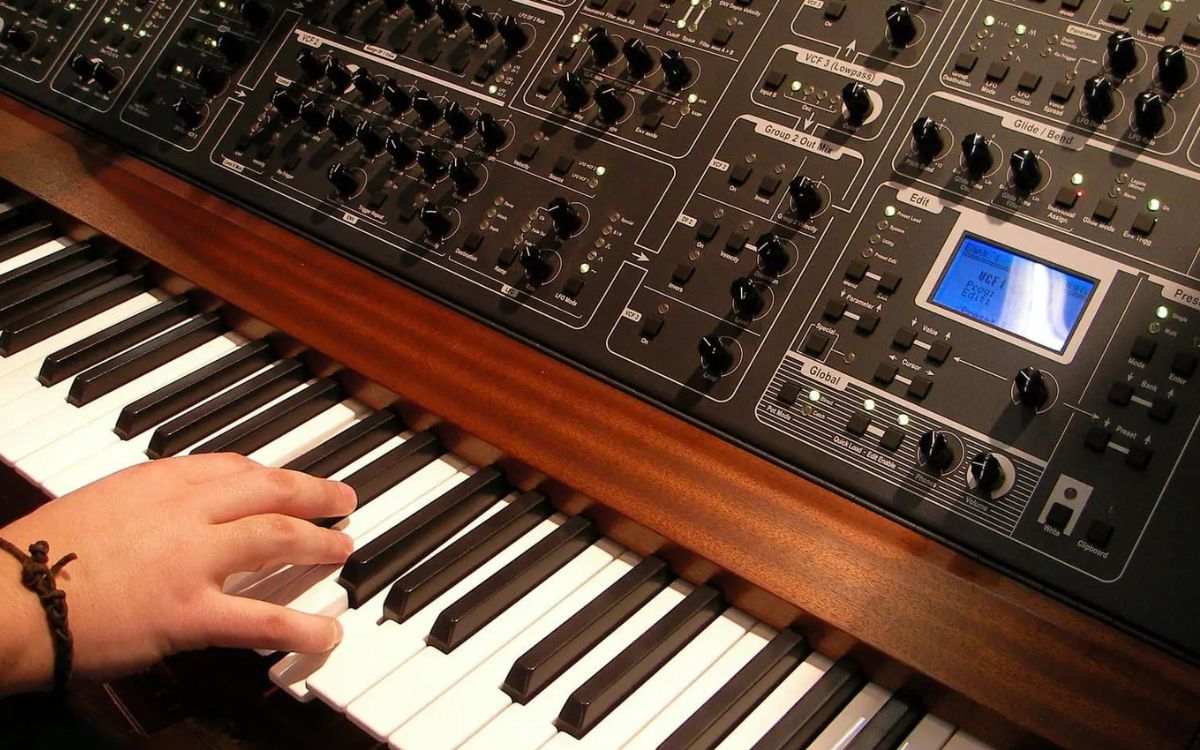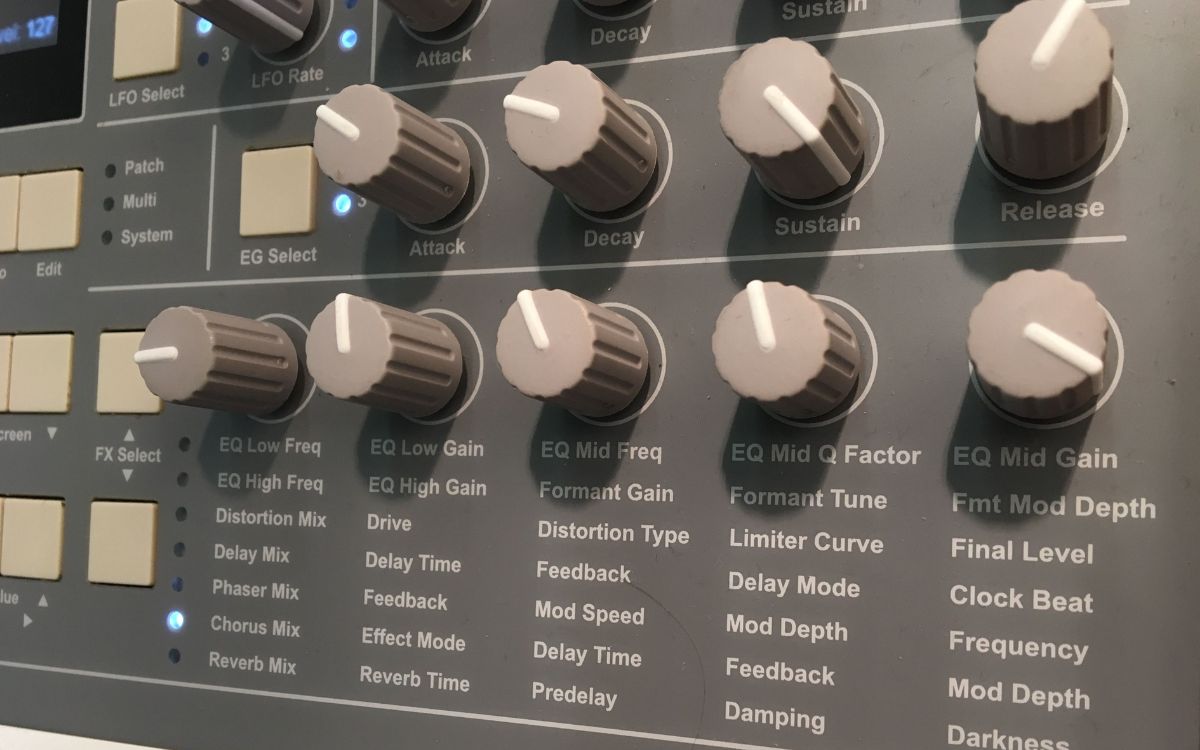Home>Instruments>Synthesizer>What Does Vco Stand For Synthesizer


Synthesizer
What Does Vco Stand For Synthesizer
Modified: January 22, 2024
Discover the meaning of VCO in the world of synthesizers. Learn what VCO stands for and how it impacts the sound creation process.
(Many of the links in this article redirect to a specific reviewed product. Your purchase of these products through affiliate links helps to generate commission for AudioLover.com, at no extra cost. Learn more)
Table of Contents
Introduction
Welcome to the fascinating world of synthesizers, where creative minds and music enthusiasts dive into the depths of sound manipulation. At the heart of these mesmerizing instruments lies the VCO, a crucial component that sets the foundation for sonic exploration. In this article, we will explore what VCO stands for in the context of synthesizers and delve into its functions, history, popular models, advantages, and disadvantages.
VCO stands for Voltage Controlled Oscillator. As the name suggests, it is an oscillator whose frequency is controlled by a voltage input. This voltage input determines the pitch of the sound produced by the VCO. In simple terms, the VCO generates an electrical signal that oscillates at a specific frequency, resulting in a sound wave with a corresponding pitch.
Without VCOs, synthesizers would not be able to produce the rich variety of tones and sounds we associate with them. VCOs serve as the building blocks of synthesis, allowing musicians and sound designers to shape and modulate sounds to their liking. They form an integral part of analog synthesizers and are also found in digital and hybrid synthesizers.
Now that we have a basic understanding of what VCO stands for let’s explore the functions of VCOs in a synthesizer and how they have evolved over time.
Definition of VCO
In the world of synthesizers, a VCO, or Voltage Controlled Oscillator, refers to an electronic oscillator that generates a continuous and periodic waveform. The frequency of this waveform is controlled by an external voltage signal. The VCO essentially serves as the sound source in a synthesizer, generating the initial waveform that can be further shaped, modulated, and processed to produce various tones and sounds.
At its core, a VCO is responsible for generating a waveform with a specific pitch. The voltage input applied to the VCO determines the frequency of the waveform, which in turn determines the pitch of the resulting sound. By varying the voltage input, musicians and sound designers can control the pitch and create different musical notes.
The waveform generated by a VCO can be of various types, including sine, triangle, sawtooth, square, and pulse waves. Each waveform has its own unique timbre and character, offering a wide range of sonic possibilities. Some VCOs also offer features such as waveform mixing, frequency modulation, and octave switching to further expand the sound palette.
VCOs are typically found in analog synthesizers, where they are implemented using electronic components such as transistors, capacitors, and resistors. However, with the advancement of technology, digital and hybrid synthesizers have also incorporated VCO-like functionality through software algorithms and specialized circuitry.
In summary, a VCO is a fundamental component in a synthesizer that generates the initial waveform, which serves as the basis for sound creation. Its frequency is controlled by an external voltage input, allowing for precise control over the pitch and tonality of the produced sound.
Functions of VCO in a Synthesizer
Within a synthesizer, the VCO plays a crucial role in shaping and producing sound. Here are some of the key functions of VCOs:
- Sound Generation: The primary function of a VCO is to generate a continuous waveform that serves as the basis for sound production. The waveform produced by the VCO determines the pitch and timbre of the sound, laying the groundwork for further manipulation.
- Pitch Control: VCOs allow musicians and sound designers to control the pitch of the generated sound by inputting a voltage signal. This voltage can be manipulated through various means such as a keyboard, sequencer, or external control voltage source, giving users the ability to play different musical notes and create melodies.
- Waveform Selection: VCOs often offer multiple waveform options, such as sine, triangle, sawtooth, square, and pulse waves. This allows synthesizer users to explore different tonal characteristics and textures, enhancing their creative possibilities.
- Frequency Modulation (FM): Many VCOs include the ability to modulate the frequency of the generated waveform using other signals. This modulation technique, known as Frequency Modulation (FM), enables complex and evolving timbral changes, adding depth and richness to the produced sound.
- Octave and Fine-Tuning: VCOs often provide octave and fine-tuning controls, allowing users to adjust the pitch with precision. This feature is particularly useful for achieving accurate pitch intervals and musical tuning.
- Synchronization: Some VCOs come equipped with synchronization capabilities, allowing them to synchronize their waveform cycles with other VCOs or external clock sources. This feature is commonly used to create rhythmic patterns and tight synchronization within a synthesizer setup.
These functions collectively make the VCO a versatile tool in sound synthesis. By manipulating the waveform, pitch, and modulation options, synthesizer users can craft an endless variety of sounds, from rich and organic textures to sharp and aggressive tones.
History of VCOs in Synthesizers
The history of VCOs in synthesizers dates back to the early days of electronic music and the development of analog synthesizers. In the 1960s, pioneers like Robert Moog, Don Buchla, and Alan R. Pearlman were at the forefront of creating innovative instruments that would shape the future of music production.
During this time, synthesizers primarily relied on voltage-controlled oscillators (VCOs), as they provided precise control over pitch and waveform generation. These early VCOs were implemented using discrete electronic components like transistors, capacitors, and resistors. They offered a variety of waveform options, including the fundamental waveforms like sine, triangle, sawtooth, and square.
As the popularity and demand for synthesizers grew in the 1970s and 1980s, manufacturers introduced more advanced and integrated VCO designs. Companies like Moog, ARP, Roland, and Yamaha began incorporating VCOs into their synthesizer models, further expanding the sonic possibilities for musicians.
The advent of digital technology in the 1980s brought about the rise of digital synthesizers that utilized digital signal processing (DSP) chips. These digital synthesizers often used digitally controlled oscillators (DCOs) instead of VCOs due to their stability and tuning accuracy. However, DCOs sought to emulate the behavior and sound of traditional VCOs, aiming to provide the warmth and character associated with analog synthesis.
In recent years, there has been a resurgence of interest in analog synthesizers, leading to a renaissance of VCO-based designs. Modern synthesizer companies, such as Korg, Moog Music, and Arturia, have embraced the analog revival and introduced new instruments that feature high-quality VCOs.
Advancements in technology have also led to the development of hybrid synthesizers, which combine the best of analog and digital worlds. These instruments often feature analog VCOs paired with digital control and modulation capabilities, offering a blend of old-school warmth and modern flexibility.
The history of VCOs in synthesizers is a story of technological innovation, musical creativity, and the continual evolution of sound generation. From the early pioneers to the current resurgence of analog synthesis, VCOs have played an integral role in shaping the landscape of electronic music and remain an essential component in modern synthesizers.
Popular VCOs in the Market
With the resurgence of analog synthesizers, there has been an abundance of VCO options available in the market. Here are some popular VCOs that have gained recognition among musicians and sound enthusiasts:
- Moog Minimoog VCO: The Moog Minimoog is an iconic synthesizer that utilizes highly regarded VCOs. Known for their rich and warm sound, Minimoog VCOs deliver classic analog tones and are prized for their musicality and stability.
- Mutable Instruments Plaits: Plaits is a versatile VCO module in the Eurorack format. It features a wide range of oscillator models, including classic waveforms, physical modeling, and granular synthesis. Plaits is lauded for its sound quality and the diverse sonic textures it offers.
- Make Noise DPO: The DPO (Dual Prismatic Oscillator) from Make Noise is a highly regarded VCO module in the Eurorack modular synth realm. It combines complex analog waveforms with innovative modulation capabilities, providing a wide range of sonic possibilities for experimental and traditional synthesis.
- Mutable Instruments Tides: Tides is a multi-function module that offers more than just a traditional VCO. It combines oscillator, LFO, and envelope generator capabilities, allowing for dynamic and evolving sounds. Tides is praised for its versatility and experimental sound shaping possibilities.
- Intellijel Dixie II+: The Dixie II+ is a compact and powerful VCO module designed for the Eurorack format. It features a wide frequency range, selectable waveforms, PWM capabilities, and linear/exponential FM. The Dixie II+ is known for its versatility and affordability.
- Arturia MicroBrute: While not strictly a standalone VCO module, the Arturia MicroBrute is a popular analog synthesizer that features a high-quality VCO. With its compact size, hands-on controls, and aggressive sound, the MicroBrute has gained a strong following among musicians and producers.
These are just a few examples of the many VCO options available in the market. Whether you are looking for classic analog tones, experimental synthesis capabilities, or budget-friendly options, there is a wide variety of VCOs to choose from to suit your specific needs and creative preferences.
Advantages and Disadvantages of VCOs
Voltage Controlled Oscillators (VCOs) have long been a cornerstone of synthesizer technology, offering unique advantages and drawbacks. Let’s explore the advantages and disadvantages of VCOs in more detail:
- Advantages:
- Rich and Warm Sound: VCOs, especially those found in analog synthesizers, are renowned for their rich and warm sound characteristics. They offer a certain depth and organic quality that many musicians and sound designers find pleasing.
- Expressive and Dynamic Control: With voltage control, musicians have expressive control over the pitch and frequency of the VCO. This allows for dynamic and nuanced performances, as the subtle changes in voltage can create expressive glides and pitch bends.
- Real-Time Modulation: VCOs can be modulated in real-time using various control voltages, enabling musicians to create evolving sounds and complex tonal changes during performances.
- Flexible Waveform Options: VCOs often provide a variety of waveform options, such as sine, triangle, sawtooth, and square waves. This versatility allows for a wide range of sonic possibilities, from smooth and mellow tones to aggressive and edgy sounds.
- Disadvantages:
- Tuning Instability: VCOs, particularly those in analog synthesizers, can be susceptible to tuning instability. Changes in temperature, power supply fluctuations, and aging components can affect the accuracy and stability of the VCO’s pitch over time.
- Warm-up Time: Some VCOs require a warm-up period before they stabilize and produce consistent frequencies. This warm-up time can range from a few minutes to several hours, which can be inconvenient for musicians needing immediate access to precise tuning.
- Calibration Difficulty: Calibrating VCOs can be a complex process that requires adjustments to the internal electronics. This calibration is necessary to ensure accurate frequency response and tracking across the entire range of the VCO.
- Size and Portability: VCOs, especially in modular synthesizers, can take up significant space and require additional modules for modulation and control. This can make setups cumbersome and less portable compared to more compact digital alternatives.
While VCOs offer unique sonic characteristics and real-time control, they do come with some challenges. Despite the disadvantages, many musicians and sound enthusiasts embrace the imperfections of VCOs, as they contribute to the distinctive and authentic analog sound that has captivated generations of music makers.
VCOs vs. DCOs
When it comes to sound synthesis, an ongoing debate exists between Voltage Controlled Oscillators (VCOs) and digitally controlled oscillators (DCOs). Let’s take a closer look at the differences between VCOs and DCOs:
VCOs: VCOs were prominently used in early analog synthesizers and are still popular among musicians who value the unique analog sound. Here are some key characteristics of VCOs:
- Analog Nature: VCOs generate waveforms using analog components such as transistors, capacitors, and resistors. This results in a warmer and more organic sound with subtle variations and imperfections.
- Tuning Instability: VCOs can be subject to tuning instability due to factors such as temperature changes and aging electronic components. This instability can add a certain character and unpredictability to the sound, but also requires regular calibration.
- Real-Time Control: VCOs respond immediately to voltage changes, allowing for expressive and dynamic control over parameters such as pitch and frequency. Musicians can manipulate and modulate VCOs in real-time to create evolving sounds.
- Waveform Variety: VCOs often offer a broad range of waveform options, including sine, triangle, sawtooth, and square waves. This versatility enables musicians to explore different tonal possibilities and textures.
DCOs: With the emergence of digital technology, digitally controlled oscillators (DCOs) became popular in the 1980s. Here are some key characteristics of DCOs:
- Digital Precision: DCOs utilize digital circuitry, providing precise and stable pitch control with accurate tuning. They are not affected by factors like temperature changes, making them reliable for consistent tuning across all octaves.
- Virtual Analog Approach: DCOs aim to emulate the sound and behavior of analog VCOs through digital algorithms. While they lack some of the imperfections and nuances of analog circuits, they offer the convenience of stable tuning and precise control.
- Wider Feature Set: DCOs often come with additional features such as built-in effects, extensive modulation options, and programmability. They can offer a more comprehensive range of sound shaping capabilities compared to traditional VCOs.
- Digital Integration: DCOs are commonly found in digital and hybrid synthesizers, where they can benefit from the integration with digital signal processing (DSP) technology for advanced sound manipulation.
The choice between VCOs and DCOs ultimately depends on the preferences and priorities of the musician or sound designer. While VCOs provide a vintage and organic sound, DCOs offer stability, precision, and a broader feature set. Many modern synthesizers combine the best of both worlds by incorporating hybrid designs, utilizing both VCO and DCO technologies to achieve a versatile and diverse sonic palette.
Conclusion
Voltage Controlled Oscillators (VCOs) are the backbone of synthesizers, shaping the foundation of sound creation and manipulation. They offer musicians and sound designers the ability to generate a wide range of tones, experiment with different waveforms, and modulate pitch and frequency in real-time. While VCOs have their advantages and disadvantages, they continue to be highly regarded for their warm and organic sound characteristics.
Throughout the history of synthesizers, VCOs have played a significant role in shaping the evolution of electronic music. From the pioneering analog synthesizers of the 1960s to the modern digital and hybrid synthesizers of today, VCOs have remained a key component in sound synthesis.
While digital technologies brought about the rise of digitally controlled oscillators (DCOs) in the 1980s, many musicians and sound enthusiasts still embrace the unique qualities of VCOs. The analog nature, real-time control, and waveform versatility of VCOs continue to inspire creativity and artistic expression.
Whether it be the iconic Moog Minimoog VCOs, the experimental possibilities of Make Noise DPO, or the sonic diversity of Mutable Instruments Plaits, there is no shortage of popular VCO options in the market. Musicians have a vast array of choices to suit their individual preferences and creative needs.
In conclusion, VCOs have left an indelible mark on the world of music synthesis, contributing to countless musical compositions and artistic visions. As technology advances and new innovations emerge, VCOs will continue to play a fundamental role in shaping the future of sound exploration and production.











